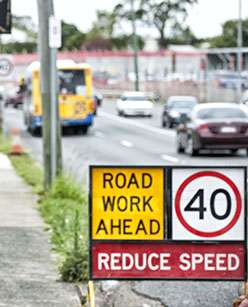Drivers go faster than what they think is safe in roadwork zones.
Drivers are traveling about 10km/h faster than they think they should through roadwork zones, according to a new QUT study which compared the speed drivers think is safe to how fast they are actually going.
Dr Ashim Debnath, from QUT's Centre for Accident Research & Road Safety – Queensland (CARRS-Q), has researched the behaviours of speeding drivers through roadwork zones and found drivers ignore their own judgement when it comes to getting behind the wheel.
Dr Debnath said in an online survey, more than 400 Queensland drivers were shown images of roadwork zones without speed limit signs and asked to nominate the speed they would drive.
He said actual driving speeds at the same roadwork zones were measured and later compared with the speeds drivers nominated in the survey.
"We found drivers were likely to nominate a lower speed than what they would actually travel at," he said.
"This is of concern because drivers are essentially ignoring their own judgment of how fast they should be driving and what they consider to be a 'safe' speed."
Dr Debnath said the study also found drivers exceeded posted speed limits through roadwork sites, with cars the worst offenders.
"The results showed that light vehicles such as cars and their followers were more likely to speed than trucks, along with leaders of convoys with a larger front gap between them and the vehicle ahead," he said.
"The study also revealed driver speeds were highest after passing the first speed reduction sign, suggesting reduced speed limits in upstream work zones may have limited effects on travel speeds."
Dr Debnath said drivers did slow down as they were passing through the roadwork zones, however many drivers still exceeded the limits at all monitoring points.
"Night-time speeds were significantly higher than daytime speeds, while drivers significantly slowed close to a stop/slow traffic controller," Dr Debnath said.
A related study showed that enforcement and variable message signage warning of police radars had the greatest effects on reducing speeds.
Dr Debnath said the study aimed to better understand the behaviours of speeding drivers through roadwork zones to help identify ways to improving compliance with speed limits.
"Little is known about the speeding behaviour of drivers in Australian roadwork zones and how their compliance with speed limits could be improved," he said.
"What we know is that speeding is common in roadwork zones and contributes to crashes.
"Statistics from other countries show that crashes in roadwork zones occur at higher rates compared to outside work zones, with speed cited as a contributing factor in about 42 per cent of all roadwork crashes."
Dr Debnath said roadwork speed limits were there for a good reason – to keep travel speeds within a safe range to ensure the safety of both motorists and roadworkers.
"It is important that motorists drive within posted limits to make Australian roadwork zones safer," he said.
More information: Ashim Kumar Debnath et al. A comparison of self-nominated and actual speeds in work zones, Transportation Research Part F: Traffic Psychology and Behaviour (2015). DOI: 10.1016/j.trf.2015.10.019
Ashim Kumar Debnath et al. A Tobit model for analyzing speed limit compliance in work zones, Safety Science (2014). DOI: 10.1016/j.ssci.2014.07.012
Provided by Queensland University of Technology






















